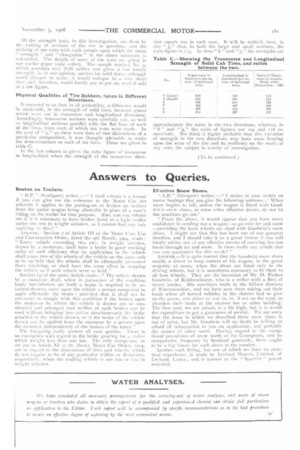Answers to Queries.
Page 15

If you've noticed an error in this article please click here to report it so we can fix it.
Brakes on Trailers.
" ;,Southport) writes :—" I shall esteem it a favour if you can give me the reference to the Motor Car Act wherein it applies to the putting-on of brakes on, trailers from the motor wagon being allowable in place of it man's riding on the trailer for that purpose. Also, can you inform me if it is necessary to have brakes fitted to a light trailer under one ton in weight unladen, as I cannot find any rule applyingto this? "
Axswailt.---Section 2 of Article III of the Motor Cars Use and Construction Order, dated the 9th March, 1904, reads : " Every vehicle exceeding two cwt. in weight unladen, drawn by a motorcar, shall have a brake in good working order of such efficiency that its application to the vehicle shall cause two of the wheels of the vehicle an the same axle to be so held that the wheels shall be effectually prevented from revolving, or shall have the same effect in stopping the vehicle as if such wheels were so held."
Section (31 of the same Article reads: 'flue The vehicle drawn by a motorcar shall, when in pursuance of the condition lastly hereinbefore set forth a brake is required lo be attached thereto, carry upon the vehicle a person competent to apply efficiently the brake : provided that it shall not be necessary to comply with this condition if the brakes upon the motorcar by which the vehicle is drawn are so constructed and arranged that neither of such brakes can be used without bringing into action simultaneously the brake attached to the vehicle drawn, or if the brake of the vehicle drawn cart he applied from the motorcar by a person upon the motorcar independently of the brakes of the latter."
The foregoing really answer all your queries. There is no exemption with regard to the brake gearing for a 'railer which weighs less than one ton. The only except oils, as set out in Article XI of the Heavy Motor Car Order, are in regard to the dimensions of tires and wheels, which do not require to be of any particular widths or diameters, respectively, when the trailing vehicle is one ton or less in weight u
El ective Snow Shoes.
" A.I3." (Glasgow) writes :—" I notice in your article on motor haulage that you give the following sentence : When snow begins to fall, unless the wagon is fitted with Goodwin's snow shoes, or some other effective device, do not let the machines go out.'
" From the above, it would appear that you have every confidence in sending out a wagon—to go over ice and snow —providing the back wheels are shod with Goodwin's snow shoes. I might say that this has been one of our greatest troubles, and I should take it as a great favour if you will kindly advise one of any effective means of carrying five-ton toads through ice and snow. Is there really any ariicle that you can guarantee for this work? " ANSWER.—i t is quite correct that the Goodwin snow shoes enable a driver to keep control of his wagon, in the great majority of cases, when the shoes are filled only to the driving wheels, but it is sometimes necessary to lit them to all four wheels. They are the invention of Mr. D. Parkes Goodwin, of Kidderminster, who is a miller with a fleet of steam lorries. His machines work in the hilliest districts of ‘Vorcestershire, and we have seen them taking out their loads when all horsed vehicles in the district had to give up die game, and either to stay in, or, if out on the road, to abandon their loads at the nearest inn or other building. The first cost, we are afraid, is a bit high, but it is worth the expenditure to get a guarantee of service. We are sorry that the issue in which we described these snow shoes is out of print, but Mr. Goodwin will no doubt be willing to afford all information to you on application, and probably the names of other users. Having regard to dui exceptional prevalence of snow north of the Grampians, and its comparative frequency in Scotland generally, there ought to be a big future for such shoes in the country. Another such fitting, but one of which we have no practical experience, is made by Ley-land Motors, Limited, of Leyland, Lancs., and is known as the " Spurrier " patent non-skid.




















